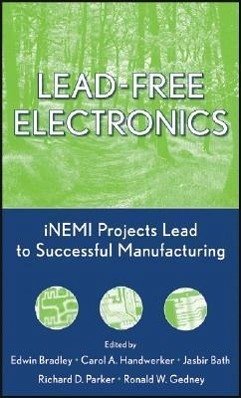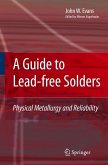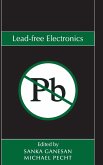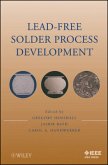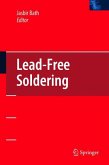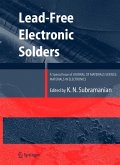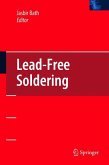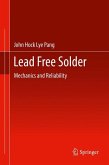Edwin Bradley, Carol A Handwerker, Jasbir Bath, Richard D Parker, Ronald W Gedney
Lead-Free Electronics
iNEMI Projects Lead to Successful Manufacturing
Edwin Bradley, Carol A Handwerker, Jasbir Bath, Richard D Parker, Ronald W Gedney
Lead-Free Electronics
iNEMI Projects Lead to Successful Manufacturing
- Gebundenes Buch
- Merkliste
- Auf die Merkliste
- Bewerten Bewerten
- Teilen
- Produkt teilen
- Produkterinnerung
- Produkterinnerung
A timely and practical treatment of implementation of lead-free solder in the manufacturing environment In order to meet new laws in Europe, electronic manufacturers around the globe have had to change over to lead-free soldering. Now, Lead-Free Electronics is the first practical, primary reference to cover lead-free solder assembly, as well as the analysis and reasoning behind the selection of Sn-Ag-Cu as the recommended lead-free replacement for Sn-Pb. Reflecting the results of a two-year study undertaken by a cross-section of some of the largest North American electronic equipment…mehr
Andere Kunden interessierten sich auch für
![A Guide to Lead-free Solders A Guide to Lead-free Solders]() John W. EvansA Guide to Lead-free Solders93,99 €
John W. EvansA Guide to Lead-free Solders93,99 €![Lead-Free Electronics Lead-Free Electronics]() Michael G. PechtLead-Free Electronics187,99 €
Michael G. PechtLead-Free Electronics187,99 €![Lead-Free Solder Process Development Lead-Free Solder Process Development]() Lead-Free Solder Process Development136,99 €
Lead-Free Solder Process Development136,99 €![Lead-Free Soldering Lead-Free Soldering]() Lead-Free Soldering105,99 €
Lead-Free Soldering105,99 €![Lead-Free Electronic Solders Lead-Free Electronic Solders]() Lead-Free Electronic Solders149,99 €
Lead-Free Electronic Solders149,99 €![Lead-Free Soldering Lead-Free Soldering]() Jasbir Singh Bath (ed.)Lead-Free Soldering75,99 €
Jasbir Singh Bath (ed.)Lead-Free Soldering75,99 €![Lead Free Solder Lead Free Solder]() John Hock Lye PangLead Free Solder75,99 €
John Hock Lye PangLead Free Solder75,99 €-
-
-
A timely and practical treatment of implementation of lead-free solder in the manufacturing environment In order to meet new laws in Europe, electronic manufacturers around the globe have had to change over to lead-free soldering. Now, Lead-Free Electronics is the first practical, primary reference to cover lead-free solder assembly, as well as the analysis and reasoning behind the selection of Sn-Ag-Cu as the recommended lead-free replacement for Sn-Pb. Reflecting the results of a two-year study undertaken by a cross-section of some of the largest North American electronic equipment manufacturers, Lead-Free Electronics provides full coverage of the issues surrounding the implementation of lead-free solder into electric board assembly. Additionally, fully documented book chapters with references to existing published work in the area make this an invaluable reference for the countless engineers and companies faced with making the switch to lead-free electronics.
Hinweis: Dieser Artikel kann nur an eine deutsche Lieferadresse ausgeliefert werden.
Hinweis: Dieser Artikel kann nur an eine deutsche Lieferadresse ausgeliefert werden.
Produktdetails
- Produktdetails
- Verlag: Wiley
- Seitenzahl: 472
- Erscheinungstermin: 1. September 2007
- Englisch
- Abmessung: 236mm x 161mm x 29mm
- Gewicht: 803g
- ISBN-13: 9780471448877
- ISBN-10: 0471448877
- Artikelnr.: 11761183
- Herstellerkennzeichnung
- Libri GmbH
- Europaallee 1
- 36244 Bad Hersfeld
- gpsr@libri.de
- Verlag: Wiley
- Seitenzahl: 472
- Erscheinungstermin: 1. September 2007
- Englisch
- Abmessung: 236mm x 161mm x 29mm
- Gewicht: 803g
- ISBN-13: 9780471448877
- ISBN-10: 0471448877
- Artikelnr.: 11761183
- Herstellerkennzeichnung
- Libri GmbH
- Europaallee 1
- 36244 Bad Hersfeld
- gpsr@libri.de
Edwin Bradley is a Distinguished Member of the Technical Staff with Motorola Advanced Product Technology Center in Plantation, Florida. He has extensive experience evaluating the materials, assembly processes, and reliability of portable electronic products, with an emphasis on lead-free soldering. Carol A. Handwerker is Professor of Materials Engineering at Purdue University. She is active on the iNEMI Technical and Research Committees. Jasbir Bath is Lead Process Engineer at Solectron Technical Centre in Milpitas, California. He has been chair of various iNEMI lead-free consortia groups. Richard D. Parker has spent nearly forty years at Delphi Electronics & Safety in Kokomo, Indiana, and he has been active in iNEMI since its inception. Ronald W. Gedney retired as vice president of operations at iNEMI and remains on as a consultant. A Fellow of the IEEE, he is also a past president of the IEEE Components, Packaging, and Manufacturing Technology (CPMT) Society.
Preface (Ronald W. Gedney).
Contributors.
Introduction (Jasbir Bath and Carol A. Handwerker).
Lead-Free Assembly Project.
Alloy Group.
Process Group.
Component Group.
Reliability Group.
Follow-On Projects/Work.
1. Alloy Selection (Carol A. Handwerker, Ursula Kattner, Kilwon Moon,
Jasbir Bath, Edwin Bradley, and Polina Snugovsky).
1.1. Introduction.
1.2. Lead-Free Alloys Considered by iNEMI in 1999 as Replacements for
Tin-Lead Eutectic Solder.
1.3. Fundamental Properties of Lead-Free Solder Alloys Affecting
Manufacturing and Reliability.
1.4. R&D Issues Remaining in Lead-Free Solder Implementation.
1.5. Summary.
References.
2. Review and Analysis of Lead-Free Solder Material Properties (Jean-Paul
Clech).
2.1. Introduction.
2.2. Tin-Lead Properties and Models.
2.3. Tin-Silver Properties and Creep Data.
2.4. Tin-Silver-Copper Properties and Creep Data.
2.5. Alloy Comparisons.
2.6. General Conclusions/Recommendations.
Appendix A: Tin-Silver Creep Data.
Appendix B: Tin-Silver-Copper Creep Data.
Acknowledgments.
References.
3. Lead-Free Solder Paste Technology (Ning-Cheng Lee).
3.1. Introduction.
3.2. Materials.
3.3. Rheology.
3.4. Applications.
3.5. Reflow Soldering.
3.6. Microstructures of Reflowed Joints.
3.7. Challenges of Lead-Free Reflow Soldering.
3.8. Summary.
References.
4. Impact of Elevated Reflow Temperatures on Component Performance
(Richard D. Parker, Jack MCCullen, Nick Lycoudes, and R. J. Arvikar).
4.1. Introduction to Component "Lead-Free" Issues.
4.2. Moisture/Reflow Impact on Packaged Integrated Circuits.
4.3. Impact of Increased Solder Peak Reflow Temperatures on Moisture
Sensitivity Level Ratings.
4.4. Impact of Increased Solder Peak Reflow Temperatures.
4.5. Observations on Profiling for the Lead-Free Reflow Processes.
4.6. IC Package Improvement Options for Better Package MSL at Higher
Lead-Free Solder Reflow Temperatures.
4.7. Frequency Control Products.
4.8. "Lead-Free" Cost Impact on Components.
4.9. Packaging Identification of Lead-free Packaged ICs.
4.10. Conclusions.
Acknowledgments.
References.
5. Lead-Free Assembly Reliability-General (Edwin Bradley).
5.1. Introduction.
5.2. Basic Physical Properties of Solder.
5.3. Creep Deformation.
5.4. Thermal Fatigue.
5.5. Creep Rupture.
5.6. Isothermal (Mechanical) Fatigue.
5.7. Out-of-Plane Bending.
5.8. Impact/Shock Loading.
5.9. Effect of Rework on Reliability.
5.10. High-Temperature Operating Life (HTOL).
5.11. Electrochemical Migration.
5.12. Tin Whiskering.
5.13. Tin Pest.
5.14. Summary.
Acknowledgments.
References.
6. Lead-Free Assembly Reliability: iNEMI Evaluation and Results (Elizabeth
Benedetto and John Sohn).
6.1. Reliability Team Goals.
6.2. Reliability Test Matrix.
6.3. Component-Paste-Board Finish Combinations.
6.4. Components.
6.5. Test Vehicles.
6.6. Pre-Test/Post-Assembly Information.
6.7. CTE Determination: Component and Boards.
6.8. Thermal Cycling Conditions.
6.9. Failure Criteria.
6.10. Thermal Cycle Relative Performance.
6.11. Failure Data, Analysis Packages.
6.12. Weibull Analyses.
6.13. Post-Cycling Failure Analysis.
6.14. Bend Testing.
6.15. Electrochemical Migration Testing [36, 37].
6.16. iNEMI Team Conclusions.
6.17. Overall Summary, Conclusions.
6.18. ASTM Test Methods.
References.
7. Tin Whiskers: Mitigation Strategies and Testing (Heidi L. Reynolds, C.
J. Lee, and Joe Smetana).
7.1. Introduction.
7.2. Mitigation Strategies.
7.3. Tin Whisker Test Development.
7.4. Summary.
Acknowledgments.
References.
8. Lead-Free Reflow and Rework (Jasbir Bath).
8.1. Introduction.
8.2. Printability of Lead-Free Solder Pastes.
8.3. Soak Versus Ramp Temperature Profiles.
8.4. Effect of Peak Temperature Versus Reflow Performance.
8.5. Effect of Reflow Atmosphere on Solderability of Lead-Free Solder.
8.6. Convection Versus IR Reflow Ovens.
8.7. Reflow Temperature Delta on Boards and Components.
8.8. Visual Inspection of Lead-Free Soldered Joints.
8.9. Automated Optical Inspection (AOI).
8.10. X-ray Inspection of Lead-Free Soldered Joints.
8.11. Acoustic Microscopy Inspection of Components Before and After
Lead-Free Reflow.
8.12. Lead-Free Rework of BGA/CSP Soldered Joints.
8.13. Lead-Free Hand-Soldering Rework.
8.14. In-Circuit Testing and Functional Testing (ICT/FT) of Soldered
Joints.
8.15. Yield Data.
8.16. Surface-Mount Fillet Lifting and Reliability of Reflowed Soldered
Joints.
8.17. Conclusions.
8.18. Future Work.
Acknowledgments.
References.
9. Case Study: Pb-Free Assembly, Rework, and Reliability Analysis of IPC
Class 2 Assemblies (Jerry Gleason, Charlie Reynolds, Matt Kelly, Jasbir
Bath, Quyen Chu, Ken Lyjak, and Patrick Roubaud).
9.1. Introduction.
9.2. Approach and Strategy.
9.3. Observations and Results.
9.4. Conclusions.
9.5. Summary.
Acknowledgments.
References.
10. Implementing RoHS and WEEE-Compliant Products (Jim MCElroy and Cynthia
Williams).
10.1. Introduction.
10.2. Are Your Products within the Scope of the EU ROHS?
10.3. Ten Steps to ROHS Compliance.
10.4. Part Numbering Important for Differentiating Lead-Free from Tin-Lead
Components and Boards.
10.5. A Standards-Based Approach to Materials Declaration.
10.6. Standards.
10.7. High-Reliability Requirements.
10.8. Business Impact of Supply Chain Conversion.
10.9. Summary.
References.
Index.
Contributors.
Introduction (Jasbir Bath and Carol A. Handwerker).
Lead-Free Assembly Project.
Alloy Group.
Process Group.
Component Group.
Reliability Group.
Follow-On Projects/Work.
1. Alloy Selection (Carol A. Handwerker, Ursula Kattner, Kilwon Moon,
Jasbir Bath, Edwin Bradley, and Polina Snugovsky).
1.1. Introduction.
1.2. Lead-Free Alloys Considered by iNEMI in 1999 as Replacements for
Tin-Lead Eutectic Solder.
1.3. Fundamental Properties of Lead-Free Solder Alloys Affecting
Manufacturing and Reliability.
1.4. R&D Issues Remaining in Lead-Free Solder Implementation.
1.5. Summary.
References.
2. Review and Analysis of Lead-Free Solder Material Properties (Jean-Paul
Clech).
2.1. Introduction.
2.2. Tin-Lead Properties and Models.
2.3. Tin-Silver Properties and Creep Data.
2.4. Tin-Silver-Copper Properties and Creep Data.
2.5. Alloy Comparisons.
2.6. General Conclusions/Recommendations.
Appendix A: Tin-Silver Creep Data.
Appendix B: Tin-Silver-Copper Creep Data.
Acknowledgments.
References.
3. Lead-Free Solder Paste Technology (Ning-Cheng Lee).
3.1. Introduction.
3.2. Materials.
3.3. Rheology.
3.4. Applications.
3.5. Reflow Soldering.
3.6. Microstructures of Reflowed Joints.
3.7. Challenges of Lead-Free Reflow Soldering.
3.8. Summary.
References.
4. Impact of Elevated Reflow Temperatures on Component Performance
(Richard D. Parker, Jack MCCullen, Nick Lycoudes, and R. J. Arvikar).
4.1. Introduction to Component "Lead-Free" Issues.
4.2. Moisture/Reflow Impact on Packaged Integrated Circuits.
4.3. Impact of Increased Solder Peak Reflow Temperatures on Moisture
Sensitivity Level Ratings.
4.4. Impact of Increased Solder Peak Reflow Temperatures.
4.5. Observations on Profiling for the Lead-Free Reflow Processes.
4.6. IC Package Improvement Options for Better Package MSL at Higher
Lead-Free Solder Reflow Temperatures.
4.7. Frequency Control Products.
4.8. "Lead-Free" Cost Impact on Components.
4.9. Packaging Identification of Lead-free Packaged ICs.
4.10. Conclusions.
Acknowledgments.
References.
5. Lead-Free Assembly Reliability-General (Edwin Bradley).
5.1. Introduction.
5.2. Basic Physical Properties of Solder.
5.3. Creep Deformation.
5.4. Thermal Fatigue.
5.5. Creep Rupture.
5.6. Isothermal (Mechanical) Fatigue.
5.7. Out-of-Plane Bending.
5.8. Impact/Shock Loading.
5.9. Effect of Rework on Reliability.
5.10. High-Temperature Operating Life (HTOL).
5.11. Electrochemical Migration.
5.12. Tin Whiskering.
5.13. Tin Pest.
5.14. Summary.
Acknowledgments.
References.
6. Lead-Free Assembly Reliability: iNEMI Evaluation and Results (Elizabeth
Benedetto and John Sohn).
6.1. Reliability Team Goals.
6.2. Reliability Test Matrix.
6.3. Component-Paste-Board Finish Combinations.
6.4. Components.
6.5. Test Vehicles.
6.6. Pre-Test/Post-Assembly Information.
6.7. CTE Determination: Component and Boards.
6.8. Thermal Cycling Conditions.
6.9. Failure Criteria.
6.10. Thermal Cycle Relative Performance.
6.11. Failure Data, Analysis Packages.
6.12. Weibull Analyses.
6.13. Post-Cycling Failure Analysis.
6.14. Bend Testing.
6.15. Electrochemical Migration Testing [36, 37].
6.16. iNEMI Team Conclusions.
6.17. Overall Summary, Conclusions.
6.18. ASTM Test Methods.
References.
7. Tin Whiskers: Mitigation Strategies and Testing (Heidi L. Reynolds, C.
J. Lee, and Joe Smetana).
7.1. Introduction.
7.2. Mitigation Strategies.
7.3. Tin Whisker Test Development.
7.4. Summary.
Acknowledgments.
References.
8. Lead-Free Reflow and Rework (Jasbir Bath).
8.1. Introduction.
8.2. Printability of Lead-Free Solder Pastes.
8.3. Soak Versus Ramp Temperature Profiles.
8.4. Effect of Peak Temperature Versus Reflow Performance.
8.5. Effect of Reflow Atmosphere on Solderability of Lead-Free Solder.
8.6. Convection Versus IR Reflow Ovens.
8.7. Reflow Temperature Delta on Boards and Components.
8.8. Visual Inspection of Lead-Free Soldered Joints.
8.9. Automated Optical Inspection (AOI).
8.10. X-ray Inspection of Lead-Free Soldered Joints.
8.11. Acoustic Microscopy Inspection of Components Before and After
Lead-Free Reflow.
8.12. Lead-Free Rework of BGA/CSP Soldered Joints.
8.13. Lead-Free Hand-Soldering Rework.
8.14. In-Circuit Testing and Functional Testing (ICT/FT) of Soldered
Joints.
8.15. Yield Data.
8.16. Surface-Mount Fillet Lifting and Reliability of Reflowed Soldered
Joints.
8.17. Conclusions.
8.18. Future Work.
Acknowledgments.
References.
9. Case Study: Pb-Free Assembly, Rework, and Reliability Analysis of IPC
Class 2 Assemblies (Jerry Gleason, Charlie Reynolds, Matt Kelly, Jasbir
Bath, Quyen Chu, Ken Lyjak, and Patrick Roubaud).
9.1. Introduction.
9.2. Approach and Strategy.
9.3. Observations and Results.
9.4. Conclusions.
9.5. Summary.
Acknowledgments.
References.
10. Implementing RoHS and WEEE-Compliant Products (Jim MCElroy and Cynthia
Williams).
10.1. Introduction.
10.2. Are Your Products within the Scope of the EU ROHS?
10.3. Ten Steps to ROHS Compliance.
10.4. Part Numbering Important for Differentiating Lead-Free from Tin-Lead
Components and Boards.
10.5. A Standards-Based Approach to Materials Declaration.
10.6. Standards.
10.7. High-Reliability Requirements.
10.8. Business Impact of Supply Chain Conversion.
10.9. Summary.
References.
Index.
Preface (Ronald W. Gedney).
Contributors.
Introduction (Jasbir Bath and Carol A. Handwerker).
Lead-Free Assembly Project.
Alloy Group.
Process Group.
Component Group.
Reliability Group.
Follow-On Projects/Work.
1. Alloy Selection (Carol A. Handwerker, Ursula Kattner, Kilwon Moon,
Jasbir Bath, Edwin Bradley, and Polina Snugovsky).
1.1. Introduction.
1.2. Lead-Free Alloys Considered by iNEMI in 1999 as Replacements for
Tin-Lead Eutectic Solder.
1.3. Fundamental Properties of Lead-Free Solder Alloys Affecting
Manufacturing and Reliability.
1.4. R&D Issues Remaining in Lead-Free Solder Implementation.
1.5. Summary.
References.
2. Review and Analysis of Lead-Free Solder Material Properties (Jean-Paul
Clech).
2.1. Introduction.
2.2. Tin-Lead Properties and Models.
2.3. Tin-Silver Properties and Creep Data.
2.4. Tin-Silver-Copper Properties and Creep Data.
2.5. Alloy Comparisons.
2.6. General Conclusions/Recommendations.
Appendix A: Tin-Silver Creep Data.
Appendix B: Tin-Silver-Copper Creep Data.
Acknowledgments.
References.
3. Lead-Free Solder Paste Technology (Ning-Cheng Lee).
3.1. Introduction.
3.2. Materials.
3.3. Rheology.
3.4. Applications.
3.5. Reflow Soldering.
3.6. Microstructures of Reflowed Joints.
3.7. Challenges of Lead-Free Reflow Soldering.
3.8. Summary.
References.
4. Impact of Elevated Reflow Temperatures on Component Performance
(Richard D. Parker, Jack MCCullen, Nick Lycoudes, and R. J. Arvikar).
4.1. Introduction to Component "Lead-Free" Issues.
4.2. Moisture/Reflow Impact on Packaged Integrated Circuits.
4.3. Impact of Increased Solder Peak Reflow Temperatures on Moisture
Sensitivity Level Ratings.
4.4. Impact of Increased Solder Peak Reflow Temperatures.
4.5. Observations on Profiling for the Lead-Free Reflow Processes.
4.6. IC Package Improvement Options for Better Package MSL at Higher
Lead-Free Solder Reflow Temperatures.
4.7. Frequency Control Products.
4.8. "Lead-Free" Cost Impact on Components.
4.9. Packaging Identification of Lead-free Packaged ICs.
4.10. Conclusions.
Acknowledgments.
References.
5. Lead-Free Assembly Reliability-General (Edwin Bradley).
5.1. Introduction.
5.2. Basic Physical Properties of Solder.
5.3. Creep Deformation.
5.4. Thermal Fatigue.
5.5. Creep Rupture.
5.6. Isothermal (Mechanical) Fatigue.
5.7. Out-of-Plane Bending.
5.8. Impact/Shock Loading.
5.9. Effect of Rework on Reliability.
5.10. High-Temperature Operating Life (HTOL).
5.11. Electrochemical Migration.
5.12. Tin Whiskering.
5.13. Tin Pest.
5.14. Summary.
Acknowledgments.
References.
6. Lead-Free Assembly Reliability: iNEMI Evaluation and Results (Elizabeth
Benedetto and John Sohn).
6.1. Reliability Team Goals.
6.2. Reliability Test Matrix.
6.3. Component-Paste-Board Finish Combinations.
6.4. Components.
6.5. Test Vehicles.
6.6. Pre-Test/Post-Assembly Information.
6.7. CTE Determination: Component and Boards.
6.8. Thermal Cycling Conditions.
6.9. Failure Criteria.
6.10. Thermal Cycle Relative Performance.
6.11. Failure Data, Analysis Packages.
6.12. Weibull Analyses.
6.13. Post-Cycling Failure Analysis.
6.14. Bend Testing.
6.15. Electrochemical Migration Testing [36, 37].
6.16. iNEMI Team Conclusions.
6.17. Overall Summary, Conclusions.
6.18. ASTM Test Methods.
References.
7. Tin Whiskers: Mitigation Strategies and Testing (Heidi L. Reynolds, C.
J. Lee, and Joe Smetana).
7.1. Introduction.
7.2. Mitigation Strategies.
7.3. Tin Whisker Test Development.
7.4. Summary.
Acknowledgments.
References.
8. Lead-Free Reflow and Rework (Jasbir Bath).
8.1. Introduction.
8.2. Printability of Lead-Free Solder Pastes.
8.3. Soak Versus Ramp Temperature Profiles.
8.4. Effect of Peak Temperature Versus Reflow Performance.
8.5. Effect of Reflow Atmosphere on Solderability of Lead-Free Solder.
8.6. Convection Versus IR Reflow Ovens.
8.7. Reflow Temperature Delta on Boards and Components.
8.8. Visual Inspection of Lead-Free Soldered Joints.
8.9. Automated Optical Inspection (AOI).
8.10. X-ray Inspection of Lead-Free Soldered Joints.
8.11. Acoustic Microscopy Inspection of Components Before and After
Lead-Free Reflow.
8.12. Lead-Free Rework of BGA/CSP Soldered Joints.
8.13. Lead-Free Hand-Soldering Rework.
8.14. In-Circuit Testing and Functional Testing (ICT/FT) of Soldered
Joints.
8.15. Yield Data.
8.16. Surface-Mount Fillet Lifting and Reliability of Reflowed Soldered
Joints.
8.17. Conclusions.
8.18. Future Work.
Acknowledgments.
References.
9. Case Study: Pb-Free Assembly, Rework, and Reliability Analysis of IPC
Class 2 Assemblies (Jerry Gleason, Charlie Reynolds, Matt Kelly, Jasbir
Bath, Quyen Chu, Ken Lyjak, and Patrick Roubaud).
9.1. Introduction.
9.2. Approach and Strategy.
9.3. Observations and Results.
9.4. Conclusions.
9.5. Summary.
Acknowledgments.
References.
10. Implementing RoHS and WEEE-Compliant Products (Jim MCElroy and Cynthia
Williams).
10.1. Introduction.
10.2. Are Your Products within the Scope of the EU ROHS?
10.3. Ten Steps to ROHS Compliance.
10.4. Part Numbering Important for Differentiating Lead-Free from Tin-Lead
Components and Boards.
10.5. A Standards-Based Approach to Materials Declaration.
10.6. Standards.
10.7. High-Reliability Requirements.
10.8. Business Impact of Supply Chain Conversion.
10.9. Summary.
References.
Index.
Contributors.
Introduction (Jasbir Bath and Carol A. Handwerker).
Lead-Free Assembly Project.
Alloy Group.
Process Group.
Component Group.
Reliability Group.
Follow-On Projects/Work.
1. Alloy Selection (Carol A. Handwerker, Ursula Kattner, Kilwon Moon,
Jasbir Bath, Edwin Bradley, and Polina Snugovsky).
1.1. Introduction.
1.2. Lead-Free Alloys Considered by iNEMI in 1999 as Replacements for
Tin-Lead Eutectic Solder.
1.3. Fundamental Properties of Lead-Free Solder Alloys Affecting
Manufacturing and Reliability.
1.4. R&D Issues Remaining in Lead-Free Solder Implementation.
1.5. Summary.
References.
2. Review and Analysis of Lead-Free Solder Material Properties (Jean-Paul
Clech).
2.1. Introduction.
2.2. Tin-Lead Properties and Models.
2.3. Tin-Silver Properties and Creep Data.
2.4. Tin-Silver-Copper Properties and Creep Data.
2.5. Alloy Comparisons.
2.6. General Conclusions/Recommendations.
Appendix A: Tin-Silver Creep Data.
Appendix B: Tin-Silver-Copper Creep Data.
Acknowledgments.
References.
3. Lead-Free Solder Paste Technology (Ning-Cheng Lee).
3.1. Introduction.
3.2. Materials.
3.3. Rheology.
3.4. Applications.
3.5. Reflow Soldering.
3.6. Microstructures of Reflowed Joints.
3.7. Challenges of Lead-Free Reflow Soldering.
3.8. Summary.
References.
4. Impact of Elevated Reflow Temperatures on Component Performance
(Richard D. Parker, Jack MCCullen, Nick Lycoudes, and R. J. Arvikar).
4.1. Introduction to Component "Lead-Free" Issues.
4.2. Moisture/Reflow Impact on Packaged Integrated Circuits.
4.3. Impact of Increased Solder Peak Reflow Temperatures on Moisture
Sensitivity Level Ratings.
4.4. Impact of Increased Solder Peak Reflow Temperatures.
4.5. Observations on Profiling for the Lead-Free Reflow Processes.
4.6. IC Package Improvement Options for Better Package MSL at Higher
Lead-Free Solder Reflow Temperatures.
4.7. Frequency Control Products.
4.8. "Lead-Free" Cost Impact on Components.
4.9. Packaging Identification of Lead-free Packaged ICs.
4.10. Conclusions.
Acknowledgments.
References.
5. Lead-Free Assembly Reliability-General (Edwin Bradley).
5.1. Introduction.
5.2. Basic Physical Properties of Solder.
5.3. Creep Deformation.
5.4. Thermal Fatigue.
5.5. Creep Rupture.
5.6. Isothermal (Mechanical) Fatigue.
5.7. Out-of-Plane Bending.
5.8. Impact/Shock Loading.
5.9. Effect of Rework on Reliability.
5.10. High-Temperature Operating Life (HTOL).
5.11. Electrochemical Migration.
5.12. Tin Whiskering.
5.13. Tin Pest.
5.14. Summary.
Acknowledgments.
References.
6. Lead-Free Assembly Reliability: iNEMI Evaluation and Results (Elizabeth
Benedetto and John Sohn).
6.1. Reliability Team Goals.
6.2. Reliability Test Matrix.
6.3. Component-Paste-Board Finish Combinations.
6.4. Components.
6.5. Test Vehicles.
6.6. Pre-Test/Post-Assembly Information.
6.7. CTE Determination: Component and Boards.
6.8. Thermal Cycling Conditions.
6.9. Failure Criteria.
6.10. Thermal Cycle Relative Performance.
6.11. Failure Data, Analysis Packages.
6.12. Weibull Analyses.
6.13. Post-Cycling Failure Analysis.
6.14. Bend Testing.
6.15. Electrochemical Migration Testing [36, 37].
6.16. iNEMI Team Conclusions.
6.17. Overall Summary, Conclusions.
6.18. ASTM Test Methods.
References.
7. Tin Whiskers: Mitigation Strategies and Testing (Heidi L. Reynolds, C.
J. Lee, and Joe Smetana).
7.1. Introduction.
7.2. Mitigation Strategies.
7.3. Tin Whisker Test Development.
7.4. Summary.
Acknowledgments.
References.
8. Lead-Free Reflow and Rework (Jasbir Bath).
8.1. Introduction.
8.2. Printability of Lead-Free Solder Pastes.
8.3. Soak Versus Ramp Temperature Profiles.
8.4. Effect of Peak Temperature Versus Reflow Performance.
8.5. Effect of Reflow Atmosphere on Solderability of Lead-Free Solder.
8.6. Convection Versus IR Reflow Ovens.
8.7. Reflow Temperature Delta on Boards and Components.
8.8. Visual Inspection of Lead-Free Soldered Joints.
8.9. Automated Optical Inspection (AOI).
8.10. X-ray Inspection of Lead-Free Soldered Joints.
8.11. Acoustic Microscopy Inspection of Components Before and After
Lead-Free Reflow.
8.12. Lead-Free Rework of BGA/CSP Soldered Joints.
8.13. Lead-Free Hand-Soldering Rework.
8.14. In-Circuit Testing and Functional Testing (ICT/FT) of Soldered
Joints.
8.15. Yield Data.
8.16. Surface-Mount Fillet Lifting and Reliability of Reflowed Soldered
Joints.
8.17. Conclusions.
8.18. Future Work.
Acknowledgments.
References.
9. Case Study: Pb-Free Assembly, Rework, and Reliability Analysis of IPC
Class 2 Assemblies (Jerry Gleason, Charlie Reynolds, Matt Kelly, Jasbir
Bath, Quyen Chu, Ken Lyjak, and Patrick Roubaud).
9.1. Introduction.
9.2. Approach and Strategy.
9.3. Observations and Results.
9.4. Conclusions.
9.5. Summary.
Acknowledgments.
References.
10. Implementing RoHS and WEEE-Compliant Products (Jim MCElroy and Cynthia
Williams).
10.1. Introduction.
10.2. Are Your Products within the Scope of the EU ROHS?
10.3. Ten Steps to ROHS Compliance.
10.4. Part Numbering Important for Differentiating Lead-Free from Tin-Lead
Components and Boards.
10.5. A Standards-Based Approach to Materials Declaration.
10.6. Standards.
10.7. High-Reliability Requirements.
10.8. Business Impact of Supply Chain Conversion.
10.9. Summary.
References.
Index.

